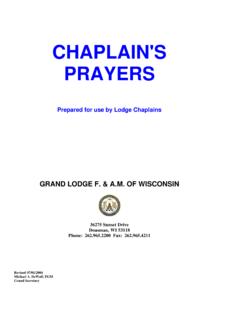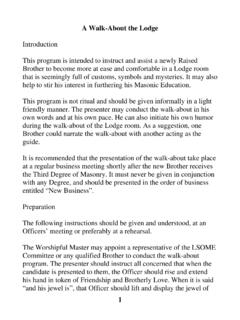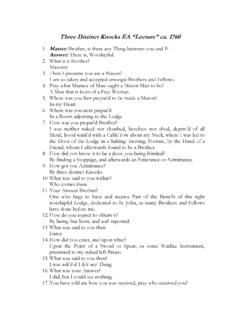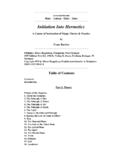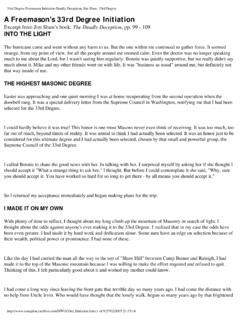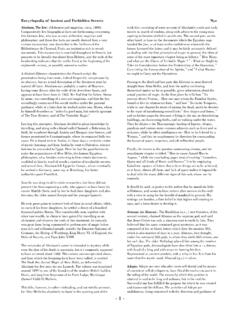Transcription of FREEMASONS' BOOK OF THE ROYAL ARCH - The Masonic …
1 freemasons ' book OF THE ROYAL ARCH BY BERNARD E. JONES ROYAL ARCHMEMBER OF QUATUOR CORONATI LODGEAUTHOR OF" freemasons ' GUIDE AND COMPENDIUM" New Impression Revised by 1 HARRY CARR, , ( ) and Secretary, Quatuor Coronati Lodgeand Editor of its Transactions and A. R. HEWITT, , ( ) andTreasurer, Quatuor Coronati LodgeLibrarian and Curator of Museum,United Grand Lodge of England With thirty-one plates in half-tone andmany line illustrations in the text GEORGE G. HARRAP & COMPANY LTD2 LONDON TORONTO WELLINGTON SYDNEY3 4 PREFACE THIS book , uniform in style and presentation with my earlier freemasons ' Guide and Compendium, which, in the main, dealt with Craft masonry, is an attempt to provide a simple explanation of the origin, rise, and development, and the customs, ritual, and symbolism, of ROYAL Arch masonry so far as present knowledge and considerations of Masonic propriety permit.
2 I use the word attempt' advisedly, for great difficulties are in the way of complete achievement in writing historically of this "elusive degree," although, let me say, in the task of coping with them I have been greatly cheered by recollections of the indulgence given me by readers of my earlier book . The greatest obstacle in the path of the writer seeking to explain the early history of ROYAL Arch masonry is his comparative ignorance of the formative days of the Order - the mid-eighteenth-century period. The facts on record are not enough to preclude different interpretations and conflicting views. Perhaps it is a slight compensation that the traditional history upon which the ceremonial of the Order is founded was clearly anticipated in published writings to an extent considerably greater than in the case of the Craft, for whereas, for example, there is hardly any recorded foreknowledge of the Third Degree Hiramic story, the Legend of the Crypt might well have been inspired by one known to have been in written form in the fourth century of the Christian era, while the sword-and-trowel motif, derived from the Old Testament account of the return of the Jews from exile, was the pride and glory of a Crusading Order of the early Middle Ages.
3 5 What I have tried to do in writing this book is to make available to Companions who have had little opportunity for specialized study an essentially readable account, as authentic as possible, of the history and lore of the ROYAL Arch, affording an insight into some matters which in the past have tended to escape the attention of all but the serious student. Not only do I hope that my readers will enjoy reading my book , but that some few of them will be able to use it as a source of material for short, simple addresses designed to arouse and foster the interest of their Companions. And most sincerely, also, do I hope that the serious student will find in it occasion for kindly, constructive criticism; indeed, I am 8 sure he will, for there are wide and unavoidable differences of opinion on some of the subjects discussed by me. The title of this book may be thought to err by omission. Inasmuch as the Articles of Union, 1813, use the term Holy ROYAL Arch' and the early Companions knew the Order by that name, it may be thought that the word Holy' ought to be included in the title and commonly used in the text.
4 True, there is history in the word. Holy' is thought to have been derived more than two centuries ago from the Antient' masons' motto, "Holiness to the Lord"; or to have been inspired by the Holy of Holies, the Inner Chamber of the Temple Sanctuary; or, again, to have reflected the religious, and even Christian, character of the primitive ROYAL Arch ceremonial. But it is to be noted that it is only sparingly used nowadays in the accepted rituals, and - a fact that has mainly influenced me - it does not form part of the titles of the Grand Chapters of England, Ireland, and So great a part of our knowledge of ROYAL Arch matters having been revealed by modern, and even quite recent, research, it follows that oldtime writings on the subject need generally to be read with caution. In no section of Masonic authorship has history been so badly served as in that of the ROYAL Arch, where the blending of fact and fancy so often causes the reader perplexity.
5 I hope that my readers will do their best to approach this book with minds open and as free as possible of preconceptions. In preparing myself for my task I have necessarily ranged over a wide variety of writings, and hope that I may fairly claim for this book what my old friend the late J. Heron Lepper so appreciatively said of my earlier one-namely, that "it provides the man who has small leisure for extensive reading with the essence and marrow of what has been accomplished in two generations of Masonic scholarship." The List of Contents and the 16-page Index reveal at a glance the very wide scope of my book . My qualifications as a ROYAL Arch mason may be briefly stated: I was exalted in the Savage Club Chapter, No. 2190, in 1913, and was in the First Principal's Chair in 1925-26. The writing of Masonic books comes at the end of a long and active life spent largely as an editor of technical books and periodicals.
6 After much desultory Masonic reading and some modest lecturing I settled down in 1945 to serious work preparatory to writing my freemasons ' Guide and Compendium, which was published in 1950, since when I have applied myself more especially to the study of ROYAL Arch masonry, and of that study this book offers the more particular Slight disparity between the opinions now expressed, particularly in the early sections of this book , and some in my other work may possibly 9 give occasion for comment. I confess that, with still wider reading and much further meditation, assisted by the results of recent research, I have come to regard the origin and rise of ROYAL Arch masonry in what I believe to be a truer perspective, allowing of my taking a more generous view of some of the questions involved. But I am very far from pretending that I am able (or that anybody ever will be able) to offer a noncontroversial account of the early history of the Order.
7 I am happy in acknowledging very considerable help extended to me in the course of gathering material for this book , and it is with gratitude that I mention especially one source of information to which I am under a heavy obligation: the late J. Heron Lepper, Librarian and Curator (1943-52) of the United Grand Lodge of England, a man of great gifts and considerable achievement, wide learning, and with profound knowledge of Masonic history, built up over the course of years a most unusual file of ROYAL Arch information (neither now nor then normally available for reference), with possibly some idea that, given opportunity, he might one day turn it to account in the printed word. Such a book , had he been spared to write it, would have been a classic, and mine would have remained unwanted and unwritten. But his opportunity did not come, for, to the sorrow of us all, he died at Christmas 1952, at the age of 8seventy-four.
8 By unique good fortune, to which my book owes very much indeed, his successor, Ivor Grantham, courteously extended to me the privilege of working steadily through Heron Lepper's file and of taking copies of any of its contents, and for this great kindness-just one of a great many from the same hands - I shall ever be grateful. My debt to two other sources, Ars Quatuor Coronatorum (the "Transactions" of Quatuor Coronati Lodge, No. 2076, the world's premier lodge of Masonic research) and Miscellanea Latomorum (let us hope only temporarily suspended), is a heavy one, for there is little on my subject in the lengthy files of these publications that I have not read in my search for enlightenment. All Masonic authors of to-day have reason to be grateful to these two remarkable founts of knowledge. To many of my fellow-members of the Quatuor Coronati Lodge (all of them authors of Masonic writings) I offer thanks for many marked kindnesses - as, for example, to John R.
9 Dashwood (Secretary and Editor of the lodge "Transactions"), for many privileges, especially his help in connexion with the history of the First Grand Chapter and his kindness in finding and lending illustrations. (His publication, in the lodge "Transactions," of the actual record of the interrogation of John Coustos by the Inquisition (1743 and 1744) and of the minutes of the chapter that so quickly became the First Grand Chapter (1766), with his comments thereon, gives us two of the most notable recent contri- 10 9butions to authentic Masonic history. I have well profited by them.) Also, I would thank Harry Carr, for his painstaking revision of the section on the Ineffable Name; George S. Draffen (Grand Librarian, Grand Lodge of Scotland), for placing his manuscript The Triple Tau at my disposal in advance of publication and for permission to quote from it; Gilbert Y.
10 Johnson, for help in connexion with the history of York ROYAL Arch masonry and for lending me his writings on the subject; Bruce W. Oliver, for his loan of an old MS. ritual, of which I have been able to make considerable use; Sydney Pope, for arranging for the photographing of an ancient banner preserved in the Canterbury Masonic Museum, of which he is Curator; Norman Rogers, for help in general and for the loan of his MS. on ROYAL Arch masonry in Lancashire; Fred L. Pick, for arranging for the loan of many photographs, some preserved in the museum of which he is Curator and others belonging to the manchester association of Masonic Research; John R. Rylands, for reading two early sections, the loan of his papers on Yorkshire ROYAL Arch masonry, and permission to use his photographs of the Wakefield jewels; William Waples, for his many notes on North-east ROYAL Arch masonry and for permission to use two photographs; and Eric Ward, for providing me with copies of minutes of old military chapters.
